BUGS, IT WHAT’S FOR DINNER!
by Beryl Rea, The Trout Scout
To view the world from the trout’s view point, to see what’s on the trout’s menu, pick up a few rocks or take a bottom sample with an aquarium net, and see what bugs you find. Under the surface there is a whole world, a community of life surviving against all kinds of obstacles, predators, water temperatures, flows and pollution, life in prehistoric forms, all which have adapted to life in the underworld, Mayflies, Caddis flies, Stoneflies, Midges and crustaceans, all part of the food chain, food for fish.
Remember collecting caterpillars as a kid (if they stayed alive long enough), they would spin a cocoon and eventually hatch into a beautiful butterfly, one of life’s little miracles. Most of the bugs underneath the water go through this same process, a complete or incomplete metamorphous. As they go through these changes and struggle to the surface they attract major attention from the fish, basically the dinner bell goes off. The more we learn about these creatures, their life changes, it will help in putting that right fly on at the right time equaling more fish. WANT MORE FISH? KNOW YOUR BUGS. Most of the insects that are fish food go through a life cycle of about a year. Developing form a tiny egg, they go through changes growing into the insect we see on or over the water. All these growth stages are important to fish.
Let’s start with the butterfly part; this is the final stage of an insect’s life, the adult, the visual part of fly fishing. This is also when the bugs reproduce, then laying their eggs back in the water they will die, and the cycle continues anew. Since this stage of a bug’s life lasts only, a day in some cases, it’s only a very small part of a fish’s diet (70-90% is underneath the surface). Understanding the changes from nymph to dun and larva to pupa to adult, in a bug’s development, help us with knowing what’s on the menu today.
THE 4 MAJOR PLAYERS
Caddis & Caddis Fly
Caddis flies: Caddis larva are fleshy, wormlike critters with 6 legs. They are unable to swim and move around like an inchworm. Some build little pebble huts, some spin nets (to collect food) some build homes form plant debris and look like sticks and others just crawl around the bottom. In their adult form they look like little moths with their wings folded like a tent over their backs. Flies: green rock worm (larva) elk hair caddis (adult)
Mayflies and Stoneflies: Have visible sets of wing cases on the thoracic segment, (Mayflies 1, Stoneflies 2) Most Mayflies have 3 tails, Stoneflies only have 2. The big difference is that Mayflies have gills on their abdominal segment and only there, stoneflies, either lack or have them on the thoracic alone. Adults; (Mayflies) wings sit upright on their body, Stoneflies; wings are flat, folded back over their body. Flies: Mayflies; (nymph) pheasant tail, (adult) Adams. Stoneflies; (nymph) little brown stone, (adult) Stimulator.
Midges: very small thin worm like creatures (pupa). Small flies, looks like a mosquito, but they do not bite (adult).
Flies: zebra midge (pupa) Griffith’s gnat (adult)
Choosing a fly: Try to match the size, shape and color of the bugs in the water, if you find a lot of little mayfly nymphs, fish a Pheasant tail in the size that’s most abundant.
Other bugs: Dragonflies, Damselflies, Scuds (little shrimplike creatures) crawfish and forage fish (streamer time). There is lots of life beneath the surface, understanding their like cycles help us become a better fly fisher.
Ralph Cutter’s book: FISH FOOD- A Fly Fisher’s Guide to Bugs and Bait is a valuable recourse to learning more.
Beryl Rea, The Trout Scout is a fly fishing guide and instructor in the Eastern Sierra.
